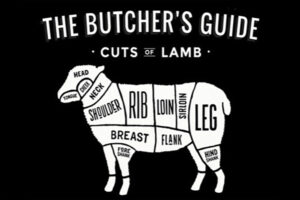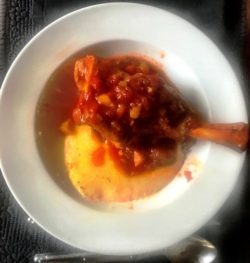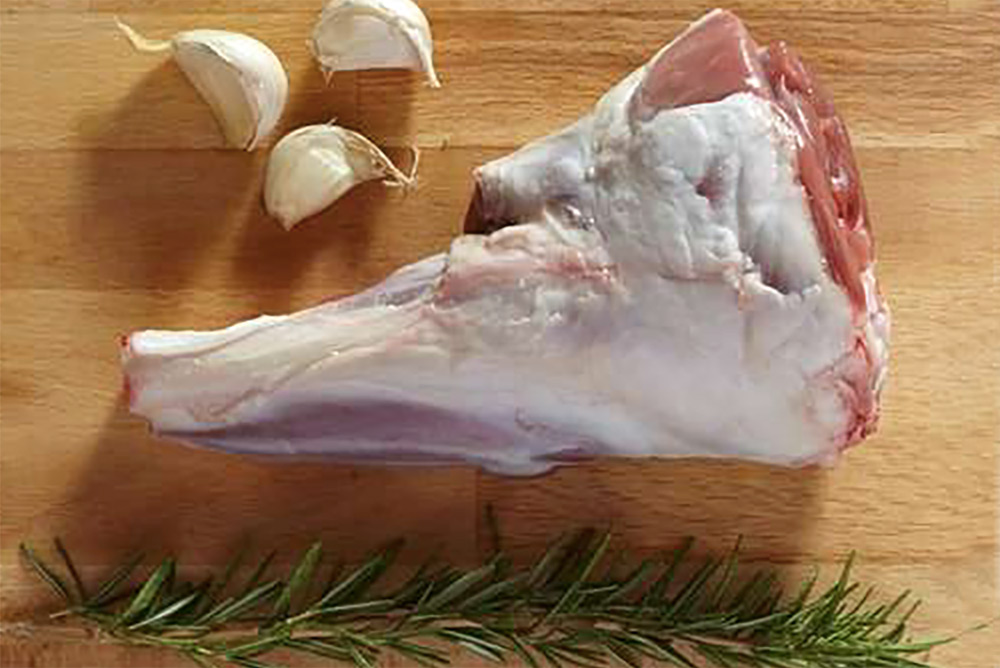By Nancy Pollard
After owning one of the best cooking stores in the US for 47 years—La Cuisine: The Cook’s Resource in Alexandria, Virginia—Nancy Pollard writes Kitchen Detail, a blog about food in all its aspects—recipes, film, books, travel, superior sources, and food-related issues.
 THIS IS A time of abundance for lamb shanks, with plenty available in preparation for “The Easter Leg of Lamb.” (Don’t panic: Easter’s not till March 31.) But the shank is a cut that is often overlooked as we reach for the more familiar racks of lamb and loin chops. At non-Easter times, I buy frozen shanks from Valentine’s Bakery & Meats* as they are not readily available in the grocery store. And actually this is a dish that does not suffer chilblains from living in sub-zero limbo.
THIS IS A time of abundance for lamb shanks, with plenty available in preparation for “The Easter Leg of Lamb.” (Don’t panic: Easter’s not till March 31.) But the shank is a cut that is often overlooked as we reach for the more familiar racks of lamb and loin chops. At non-Easter times, I buy frozen shanks from Valentine’s Bakery & Meats* as they are not readily available in the grocery store. And actually this is a dish that does not suffer chilblains from living in sub-zero limbo.
 It’s a no-frills and easy-to-accomplish main course for both winter and early spring (a/k/a “pretend spring”). As you know, I picture March as winter dragging its feet out the door. Leftover sauce from this dish can be used for a pasta first course or even turned into a soup base with dried beans for another meal. I found this version on Epicurious, and the rave reviews are spot on. It is both easy and drop-dead delicious. It reflects similar dishes found on Italian cooking websites. I save the shank bones for mixed bone stock in the freezer: It’s amazing how quickly they pile up enough to make about a gallon of stock, with the simple addition of a bag of frozen onion, carrot and celery odds and ends that have retired to their fainting couches in the fridge. The UK division of Kitchen Detail, however, gives the shank bones to their dogs for a treat. (We are dogless at the moment or I might do the same!)
It’s a no-frills and easy-to-accomplish main course for both winter and early spring (a/k/a “pretend spring”). As you know, I picture March as winter dragging its feet out the door. Leftover sauce from this dish can be used for a pasta first course or even turned into a soup base with dried beans for another meal. I found this version on Epicurious, and the rave reviews are spot on. It is both easy and drop-dead delicious. It reflects similar dishes found on Italian cooking websites. I save the shank bones for mixed bone stock in the freezer: It’s amazing how quickly they pile up enough to make about a gallon of stock, with the simple addition of a bag of frozen onion, carrot and celery odds and ends that have retired to their fainting couches in the fridge. The UK division of Kitchen Detail, however, gives the shank bones to their dogs for a treat. (We are dogless at the moment or I might do the same!)
Dent vs. Flint
Braised lamb shanks offer the perfect excuse to make a big pot of polenta. The leftover polenta, if you have used water or stock, can be made into a yummy side dish, grilled or sautéed. Once you serve the polenta with the meat from the lamb shanks in wide pasta bowls or plates, scrape the leftover polenta into a shallow container (I usually butter mine), spread it out, cover the container and, in the next couple of days, cut the congealed polenta into whatever geometric shape you want. Grill these on a medium-hot cast-iron or carbon-steel pan. Serve with sausages or another meaty leftover. Right now I am cooking with the polenta (as well as their grits) from Wades Mill in Virginia and have found it to be outstanding.
There is actually a difference between polenta and grits, and it is in the choice of corn. Just in case you need some cocktail-party knowledge, here’s some insider info according to the ever-resourceful website the kitchn,
Most grits in the South are traditionally made from a class of corn called dent corn, whereas in Italy, most polenta is made from a class of corn called flint corn, which holds its texture better. Why do these different classes matter? Because of the different types of corn, grits will cook into a softer texture while polenta is often more coarse and toothsome.
Something I learned from Bill Buford in his memoir Heat is that polenta is very forgiving and does not need to be stirred constantly. You can add liquid to it at any time. The important thing is that it becomes creamy and unctuous, so you can check on it, stir and adjust, and walk away and enjoy your aperitivo. It really is one of the most imperturbable side dishes you can make.
* If you live in the Washington DC area, you can pick up Valentine’s lamb orders in several northern Virginia towns. For those elsewhere, the well-known purveyor D’Artagnan offers lamb shanks, fresh or frozen, for delivery.

- 6 medium lamb shanks (4½ pounds or a bit over 2kg)
- 3 tablespoons (45ml) olive oil
- 1 large onion peeled and cut into ½-inch dice
- 3 large carrots, peeled and cut into ½-inch dice
- 4 large celery stalks, cut into ½-inch dice
- 6 large garlic cloves, peeled and chopped
- 1 28-ounce can (828ml) diced tomatoes in juice
- 2¼ cups (532ml) chicken broth
- 3 large fresh rosemary sprigs
- 3 large fresh thyme sprigs plus 2 teaspoons minced thyme for the polenta
- 1 tablespoon (7gr) whole black peppercorns
- 8 cups (2ltr) water
- 1 tablespoon (17gr) sea salt
- 2 cups (473ml) polenta
- ¼ cup (52gr) butter
- 2 to 3 sprigs fresh thyme
- Preheat oven to 350F (170C). Sprinkle lamb shanks with salt and freshly ground pepper.
- Heat 2 tablespoons oil in a large ovenproof pot over high heat and add the lamb shanks as you can so that they brown evenly on all sides. Should take about 10 to 15 minutes.Transfer lamb shanks to a plate and set aside.
- Add an additional tablespoon of oil to the pot.
- Add the diced onion, celery, carrot and garlic and sauté them until they are soft and you have some brown bits in your pan.
- Add the lamb shanks back into the pot and press them into the vegetables before adding the tomatoes and stock.
- You can tie together the rosemary and thyme springs before adding them along with the whole peppercorns.
- Bring this mixture to a boil over high heat, and then cover the pot and transfer it to the oven.
- Roast until the meat is tender and pulls easily from the bone, turning occasionally. This should take no more than 2 hours.
- Meanwhile, bring 8 cups water and salt to boil in a large saucepan over high heat.
- Gradually pour the polenta in a thin stream into the water while whisking so that lumps do not occur.
- Reduce heat to low and allow it to simmer, stirring the polenta just occasionally.
- The polenta should be creamy and the grains swollen before you whisk in the butter and sprinkle in the thyme.
- Adjust the seasoning with salt and pepper.
- Remove the lamb from the pot and discard the herbs.
- Place the pot over medium-high heat and reduce the sauce so it is thickened to your liking, about 5 minutes.
- Divide the polenta among 6 large pasta bowls, top each with a lamb shank and pour over some sauce and serve.



